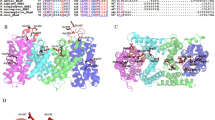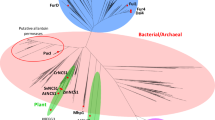Abstract
In Saccharomyces cerevisiae, the high-affinity phosphate transport system comprises the Pho84 and Pho89 permeases. The Pho89 permease catalyzes import of inorganic phosphate in a symport manner by utilizing Na+ ions as co-solute. We have addressed the functional importance of two glutamic acid residues at positions 55 and 491. Both residues are highly conserved amongst members of the inorganic phosphate transporter (PiT) family, which might be an indication of functional importance. Moreover, both residues have been shown to be of critical importance in the hPit2 transporter. We have created site-directed mutations of both E55 and E491 to lysine and glutamine. We observed that in all four cases there is a dramatic impact on the transport activity, and thus it seems that they indeed are of functional importance. Following these observations, we addressed the membrane topology of this protein by using several prediction programs. TOPCONS predicts a 7-5 transmembrane segment organization, which is the most concise topology as compared to the hPiT2 transporter. By understanding the functionality of these residues, we are able to correlate the Pho89 topology to that of the hPiT2, and can now further analyze residues which might play a role in the transport activity.
Similar content being viewed by others
Abbreviations
- GlpT:
-
glycerol-3-phosphate transporter
- LPi:
-
low phosphate media
- Pi:
-
inorganic phosphate
- PiT:
-
inorganic phosphate transporter
- PMSF:
-
phenylmethylsulphonyl fluoride
- SC:
-
synthetic complete
- TM:
-
transmembrane
- WT:
-
wild type
- YPD:
-
yeast-extract-peptone-dextrose
References
Bernsel A., Wiklund H., Hennerdal A. & Elofson A. 2009. TOPCONS: consensus prediction of membrane protein topology. Nucleic Acids Res. 37(Web Server issue): W465–W468.
Bøttger P. & Pedersen L. 2002. Two highly conserved glutamate residues critical for type III sodium-dependent phosphate transport revealed by uncoupling transport function from retroviral receptor function. J. Biol. Chem. 277: 42741–42747.
Bøttger P. & Pedersen L. 2011. Mapping of the minimal inorganic phosphate transporting unit of human PiT2 suggests a structure universal to PiT-related proteins from all kingdoms of life. BMC Biochem. 17: 12–21.
Bun-ya M., Shikata K., Nakade S., Yompakdee C., Harashima S. & Oshima Y. 1996. Two new genes, PHO86 and PHO87, involved in inorganic phosphate uptake in Saccharomyces cerevisiae. Curr. Genet. 29: 344–351.
Bun-ya M., Nishimura M., Harashima S. & Oshima Y. 1991. The Pho84 gene of Saccharomyces cerevisiae encodes an inorganic phosphate transporter. Mol. Cell. Biol. 11: 3229–3238.
De Antoni A. & Gallwitz D. 2000. A novel multi-purpose cassette for repeated integrative epitope tagging of genes in Saccharomyces cerevisiae. Gene 246: 179–185.
Ghillebert R., Swinnen E., De Snijder P., Smets B. & Winderickx J. 2011. Differential roles for the low-affinity phosphate transporters Pho87 and Pho90 in Saccharomyces cerevisiae. Biochem. J. 11: 243–251.
Gietz R.D. & Woods R.A. 2002. Transformation of yeast by lithium acetate/single-stranded carrier DNA/polyethylene glycol method. Methods Enzymol. 350: 87–96.
Huang Y.F., Lemieux M.J., Song J.M., Auer M. & Wang D.N. 2003. Structure and mechanism of the glycerol-3-phosphate transporter from Escherichia coli. Science 301: 616–620.
Jono S., McKee M.D., Murry C.E., Shioi A., Nishizawa Y., Mori K. & Giachelli C.M. 2000. Phosphate regulation of vascular smooth muscle cell calcification. Circ. Res. 87: E10–E17.
Krogh A., Larsson B., von Heijne G. & Sonnhammer E.L.L. 2001. Predicting transmembrane protein topology with a hidden Markov model: application to complete genomes. J. Mol. Biol. 305: 567–580.
Laemmli U.K. 1970. Cleavage of structural proteins during the assembly of the head of bacteriophage T4. Nature 227: 680–685.
Lagerstedt J.O., Voss J.C., Wieslander A. & Persson B.L. 2004. Structural modeling of dual-affinity purified Pho84 phosphate transporter. FEBS Lett. 578: 262–268.
Lundh F., Mouillon J.M., Samyn D., Stadler K., Popova Y., Lagerstedt J.O., Thevelein J.M. & Persson B.L. 2009. Molecular mechanisms controlling phosphate-induced downregulation of the yeast Pho84 phosphate transporter. Biochemistry 48: 4497–4505.
Martinez P. & Persson B.L. 1998. Identification, cloning and characterization of a derepressible Na+ -coupled phosphate transporter in Saccharomyces cerevisiae. Mol. Gen. Genet. 258: 628–638.
Miller D.G., Edwards R.H. & Miller A.D. 1994. Cloning of the cellular receptor for amphotropic murine retroviruses reveals homology to that for gibbon ape leukemia virus. Proc. Nat. Acad. Sci. USA 91: 78–82.
Mouillon J.M. & Persson B.L. 2006. New aspects on phosphate sensing and signalling in Saccharomyces cerevisiae. FEMS Yeast Res. 6: 171–176.
Ogawa N. & DeRisi J. 2000. New components of a system for phosphate accumulation and polyphosphate metabolism in Saccharomyces cerevisiae revealed by genomic expression analysis. Mol. Biol. Cell. 11: 4309–4321.
Oshima Y. 1997. The phosphatase system in Saccharomyces cerevisiae. Genes Gen. Sys. 72: 323–334.
Palmer G., Zhao J., Bonjour J., Hofstetter W. & Caverzasio J. 1999. In vivo expression of transcripts encoding the Glvr-1 phosphate transporter/retrovirus receptor during bone development. Bone 24: 1–7.
Salaün C., Rodrigues P. & Heard J.M. 2001. Transmembrane topology of PiT-2, a phosphate transporter-retrovirus receptor. J. Virol. 75: 5584–5592.
Tailor C. S., Takeuchi Y., O’Hara B., Weiss R.A. & Collins M.K. 1993. Mutation of amino acids within the gibbon ape leukemia virus (GALV) receptor differentially affects feline leukemia virus subgroup B, simian sarcoma-associated virus, and GALV infections. J. Virol. 67: 6737–6741.
Tamai Y., Toh-e A., & Oshima Y. 1985. Regulation of inorganic phosphate transport systems in Saccharomyces cerevisiae. J. Bacteriol. 164: 964–968.
Tusnady G.E. & Simon, I. 2001. The HMMTOP transmembrane topology prediction server. Bioinformatics 17: 849–850.
Wang C., Li Y., Shi L., Ren J., Patti M., Wang T., de Oliveira J. R., Sobrido M. J., Quintáns B., Baquero M., Cui X., Zhang X. Y., Wang L., Xu H., Wang J., Yao J., Dai X., Liu J., Zhang L., Ma H., Gao Y., Ma X., Feng S., Liu M., Wang Q.K., Forster I.C., Zhang X., Liu J.Y. 2012. Mutations in SLC20A2 link familial idiopathic basal ganglia calcification with phosphate homeostasis. Nat. Genet. 44: 254–256.
Wykoff D. & O’shea E.K. 2001. Phosphate transport and sensing in Saccharomyces cerevisiae. Genetics 159: 1491–1499.
Zvyagilskaya R.A., Lundh F., Samyn D., Pattison-Granberg J., Mouillon J.M., Popova Y., Thevelein J.M. & Persson B.L. 2008. Characterization of the Pho89 phosphate transporter by functional hyperexpression in Saccharomyces cerevisiae. FEMS Yeast Res. 8: 685–696.
Author information
Authors and Affiliations
Corresponding author
Rights and permissions
About this article
Cite this article
Andersson, M.R., Samyn, D.R. & Persson, B.L. Mutational analysis of conserved glutamic acids of Pho89, a Saccharomyces cerevisiae high-affinity inorganic phosphate:Na+ symporter. Biologia 67, 1056–1061 (2012). https://doi.org/10.2478/s11756-012-0118-6
Received:
Accepted:
Published:
Issue Date:
DOI: https://doi.org/10.2478/s11756-012-0118-6




